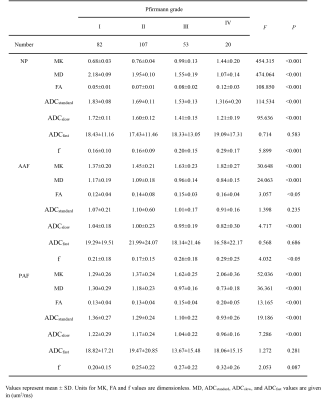2823
Diffusion kurtosis imaging and intravoxel incoherent motion in quantitative evalutation of lumbar intervertebral disc degeneration1Radiology, Renmin Hospital of Wuhan University, Wuhan, China, 2Renmin Hospital of Wuhan University, Wuhan, China, 3MR Research, GE Healthcare, Bejing, China
Synopsis
The purpose of this study is to compare the diagnostic value of diffusion kurtosis imaging (DKI) and intravoxel incoherent motion(IVIM) in assessing lumbar intervertebral disc degeneration. DKI parameters ( MK, MD, and FA), and IVIM parameters (ADCstandard, ADCslow, ADCfast, and f) of nucleus pulposus (NP), anterior annulus fibrosus (AAF) and posterior annulus fibrosus (PAF) were measured and correlated with Pfirrmann grades. It was found that DKI and IVIM parameters had significantly correlation with Pfirrmann grades. In addition, DKI was more sensitive than IVIM in quantitative detection of early lumbar intervertebral disc degeneration.
Introduction
Intervertebral disk degeneration (IVDD) is a leading cause of lumbar spine related low back pain. Multiple factors, such as cell aging, dystrophia, biomechanical changes, may lead to intervertebral disc proteoglycan degradation and loss of collagen and water, which finally resulting in degeneration. The alteration of water moleculare diffusion process is regard as a mark of early lumbar intervertebral disc degeneration [1]. Recently, DKI was found to be can sensitivelybly reflect the non-Gaussian properties of water moleculare diffusion and the complexity of tissue microstructures [2]. IVIM model attributes DWI signal changes in the low b-value range to microcirculatory perfusion, while signal changes in the high b-value range reflect true molecular diffusion[3]. Previous study of rat tail intervertebral disc model and human lumbar disc study have demonstrated the feasibility of detecting early intervertebral disc degeneration with DKI [4,5]. The purpose of this study is to compare the diagnostic value of DKI and IVIM in quantitative evaluation of IVDD.Method
In all, 53 patients (28 female, 25 male, mean age 37.5±11.2 years) with low back pain or sciatica were recruited in this study. All the participants underwent MR exams including sagittal T2WI as well as DKI and IVIM imaging on a 3.0T MR scanner (Discovery MR750, GE Healthcare). The lumbar discs were classified into five grades according to the conventional Pfirrmann grade system [6] by two experienced radiologists. The acquired MR images (grades I–IV) were transferred to a vendor-offered workstation (Advantage Workstation 4.6, GE Healthcare) for post-processing. For each disc, five consecutive ROIs (Fig. 1) were placed on the DKI parameters (mean kurtosis [MK], mean diffusivity [MD], fractional anisotropy [FA]), and IVIM parameters (standard apparent diffusion coefficient [ADCstandard], slow ADC [ADCslow], ADC [ADCfast], and perfusion fraction [f]) maps to represent five parts of the disc. The ROI1 and ROI5 averaged measurements respectively represented of AAF and PAF, respectively. And the ROI2, ROI3 and ROI4 represented NP. Spearman correlation was performed to investigate the relationship between values of each computed parameter and Pfirrmann grade.Results
The mean values of each parameter for each Pfirrmann grade were shown in Table 1. Pfirrmann grades were significantly correlated with measured parameters in AAF, NP, and PAF (Table 2).Discussion
DKI is a natural extension of diffusion tensor imaging (DTI). DKI can provide more accurate information about water diffusion and tissue microstructure than conventional diffusion weighted imaging (DWI) and DTI. For IVIM, both molecular diffusion and perfusion-related diffusion can be monitored by allowing the extraction of molecular diffusion coefficient (ADCslow), the perfusion-related D (ADCstandard), and perfusion fraction (f). In this study, our results showed that DKI and IVIM related parameters had significantly association with Pfirrmann grade, especially in MK, MD, FA, ADCslow, ADCfast, and f, which demonstrated that the arrangement of collagenous fiber in intervertebral disc changed from orderd mode to disordered mode with the loss of collagen and water. Additionally, DKI and IVIM techniques were more sensitive in detecting the diffusion of water in IVDD. In contrast, DKI parameters (MK and MD) performed better efficacy than IVIM parameters.Conclusion
DKI and IVIM parameters had significantly correlation with Pfirrmann grades. DKI was more sensitive than IVIM mapping in quantitative detection of early lumbar IVDD.Acknowledgements
I would like to thank my supervisor Professor Yunfei Zha for his guidance and Weiyin Liu from GE Healthcare for her technical assistance.References
1. Cui YZ, Yang XH , Liu PF,et al.Preliminary study on diagnosis of lumbar disc degeneration with magnetic resonanceT1ρ, T2 mapping and DWI quantitative detection technologies[J]. Eur Rev Med Pharmacol Sci, 2016,20(16):3344-3350.
2. Jensen JH, Helpern JA, Ramani A, et al. Diffusional kurtosis imaging:the quantification of non-gaussian water diffusion by means of magnetic resonance imaging[J]. Magn Reson Med, 2005, 53(6):1432-1440.
3. Bourillon C, Rahmouni A, Lin C, et al. Intravoxel Incoherent Motion Diffusion-weighted Imaging of Multiple Myeloma Lesions: Correlation with Whole-Body Dynamic Contrast Agent-enhanced MR Imaging[J]. Radiology,2015,277(3):773-83.
4. Li L, Zhu WZ, Chen WW, et al. The study of the intervertebral disc microstructure in matured rats with diffusion kurtosis imaging[J]. Magnetic Resonance Imaging, 2017, 42:101-106.
5. Zeng FF, Zha YF, Li L, et al. A comparative study of diffusion kurtosis imaging and T2* mapping in quantitative detection of lumbar intervertebral disk degeneration[J]. Eur Spine J, 2019,28(9):2169-2178.
6. Pfirrmann CW, Metzdorf A, Zanetti M, et al. Magnetic resonance classification of lumbar intervertebral disc degeneration[J]. Spine, 2001, 26(17): 1873-1878.
Figures


